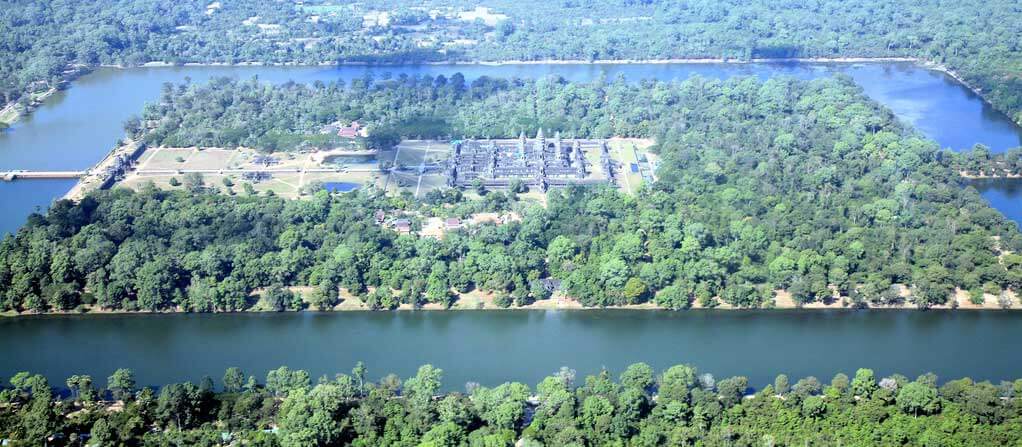
Exploring Angkor Wat
Just over 3 miles north of Siem Reap is the UNESCO World Heritage site, Angkor Wat.
This stunning collection of remarkable Hindu and Buddhist temples is one of the "Seven Wonders Of The World".
A visit offers a unique opportunity to experience Hindu and Buddhist cultures within a single landmark that is the world's largest religious monument.
Located at the heart of the 400 km² Angkor Archaeological Park, Angkor Wat is a symbol of Cambodia - its profile even appears on the national flag and it is the country's most visited attraction.
Angkor Wat - a Brief History
Angkor was the majestic capital of the powerful Khmer Empire from 9th to the 15th centuries. The temples were built by King Suryavarman II in the 12th century and bear witness to the Khmer's enormous wealth, impressive cultural and artistic abilities. At the time, Angkor was the largest urban centre in the world.

For six centuries, Angkor underwent many architectural and religious transformations - from worshiping the Hindu god Shiva to Vishnu, and finally to the Mahayana Buddhist deity Avalokitesvara.
By late 13th century, Angkor adopted Theravada Buddhism. However, with the fall of the Khmer Empire in the 15th century, the golden age of Angkor concluded.
The temples receded into the jungle. The Theravada Buddhist monks took over Angkor Wat, and thanks to them, the temple remains mostly intact.
What to See
Angkor Wat consists of five central shrines, encircled by a massive moat and three galleries. The pillars and ceilings of the galleries was decorated with lotus rosettes, apsaras (heavenly nymphs), dancing male figures on prancing animals and motifs of gods, as well as walls showing scenes of legends and ancient combats.
The five central shrines have three levels, connected by numerous exterior staircases. The temple culminates in the sanctuary, a great central tower pyramidal in form with towers surmounting the terraces of the two upper levels.
Some visitors to Angkor Wat gain insights into Buddhism or archaeology. Others seek to connect with the spiritual energy of the temple. Visit at the right time, and you can see the dawn or the sunset framed in temple spires.

Besides Angkor Wat, the three other “must-sees” temples are the Bayon, Preah Khan and Ta Prohm. The smaller temples, Neak Pean and Ta Som are also worth exploring.
When to Go
The best time to visit Angkor Wat is between November to March. You can expect cool, dry days. Angkor Wat is less crowded between June to October, but be prepared for hot and potentially wet weather. Avoid April as it will be sizzling hot.
Click here for information on how to get to Angkor, where to stay and the local gay scene.
How Long
One day is really not enough time to explore all the major sights. But after two or three days exploring, most tourists will be "templed out".
Angkor Pass
All foreigners have to purchase a pass to enter the Angkor park. These can be purchased at the front gate for 1-day (US$20), 3-day (US$40), or 7-day (US$60) duration. A 3-day pass is valid for any 3 days within a week. A 7-day pass is valid for any 7 days within a month.
Cambodians enter for free so your guide or driver will not need a pass. You can enter the park after 5pm to view the sunset without it counting as use of a day on your pass.
Guides
Guides cost around US$20-25 a day. Guides are available for most major languages. Hiring a guide is a really good idea as there is so much to see; a guide can help make sure you optimize your available time.

What to Look out for
Tuk-tuk drivers in Siem Reap may try to make you hire them as your guide. Their English and their knowledge about Angkor Wat is likely to be limited. All hotels will be able to arrange an English-speaking guide and transport.
Only purchase Angkor Park passes official Apsara Authority counters - not other vendors, and NEVER second-hand.
Make sure your clothing is modest as a respect to the local culture.
Be careful when drinking from chilled cans or bottles sold by street vendors. The ice used to chill the can may not be hygienic - use a clean straw rather than drink from a can.
Click here for Gay Siem Reap Index
Picture Acknowledgements - Steve Jurveston, Dennis Jarvis, Joana Gomez
Join the Travel Gay Newsletter
More Gay Travel News, Interviews and Features
The Best Tours In Siem Reap
Browse a selection of tours in Siem Reap from our partners with free cancellation 24 hours before your tour starts.
